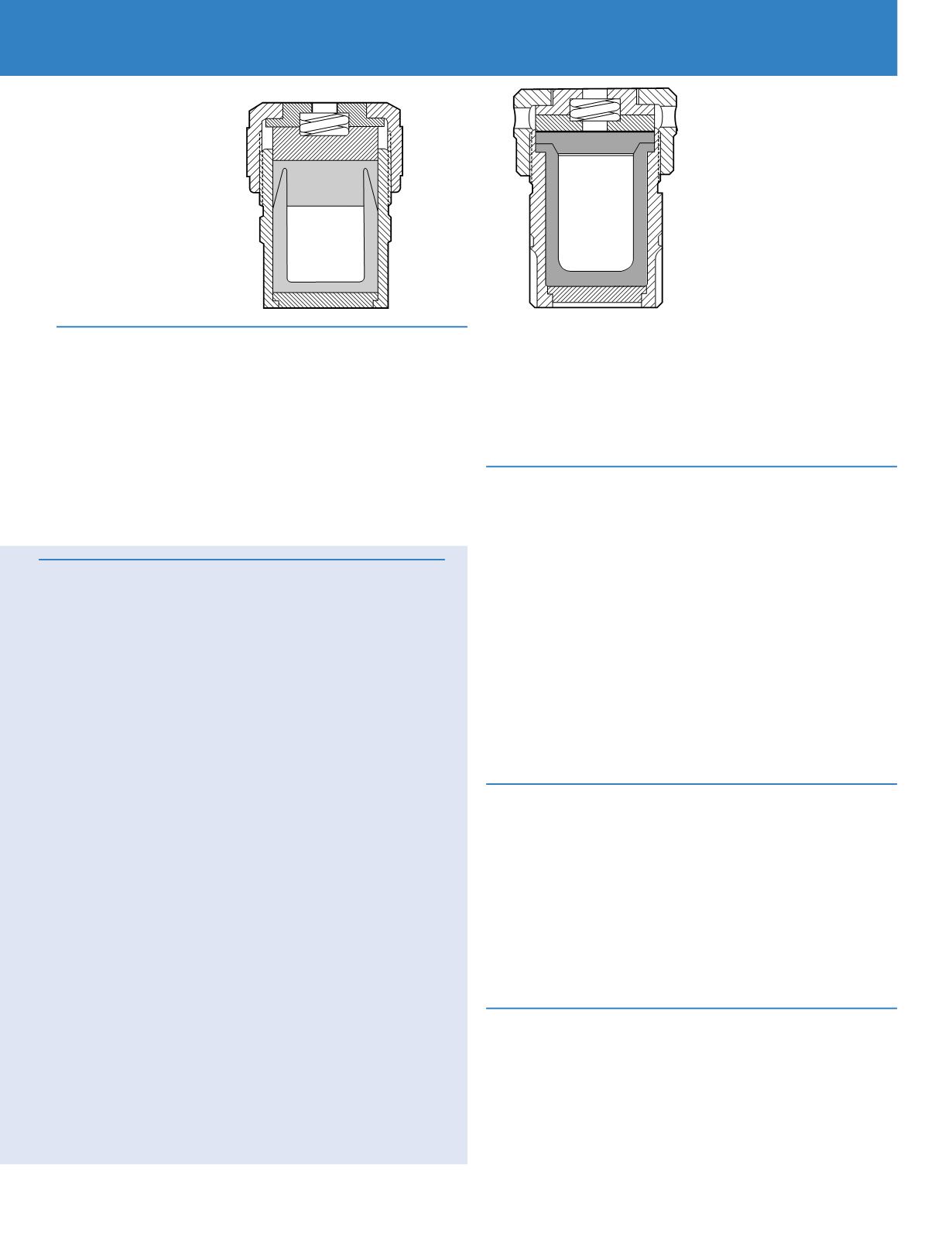
4
Parr Instrument
Acid Digestion Bombs
potentially hazardous samples. Each of these bombs has a thick-
walled Teflon liner which completely isolates the charge from the
supporting body. These liners are removable and can be charged
or emptied while outside of the bomb to eliminate any possible
contamination from acid contact with metal parts. They can be
replaced if they become damaged or contaminated.
UNIQUE CLOSURES
Several designs are used to keep Parr acid digestion bombs
tightly sealed during consecutive heating and cooling cycles when
conventional seals might leak. One of these designs uses a
tapered closure between the Teflon cup and cover with an
unusually long sealing face which tends to become self-sealing.
This long path also minimizes the tendency for acid migration
through the joint. Bombs using this design can be sealed by
simply turning down a knurled cap by hand without using a
wrench or spanner. For applications requiring higher temperatures
and pressures, the Teflon lines are made with a broad, flanged
closure and sealed by tightening the bomb cap with a spanner or,
in a larger design, by using cap screws to develop the sealing
force. Tight closures for the Teflon cup in Parr microwave bombs
are developed and maintained with self-sealing Teflon O-rings.
SPRING-LOADED SEALS
Since Teflon has a much larger coefficient of thermal
expansion than the materials within which a liner is enclosed, a
Teflon liner will expand and contract more than its enclosure
when these bombs are heated and cooled. To compensate for this
difference and to maintain a constant loading on the Teflon seal,
all Parr acid digestion bombs have spring-loaded closures which
will continue to maintain pressure on the liner seal throughout
the operating cycle, and particularly during cooling when Teflon
parts would otherwise relax and leak.
SAFETY RUPTURE DISCS
Safety rupture discs are provided in most Parr acid digestion
bombs to protect the bomb and the operator from the hazards of
unexpected or dangerously high internal pressures. The burst
pressure in each installation is established by a frangible metal
disc installed as a sandwich with a matching inner disc which
serves as a corrosion barrier to protect the rupture disc from
corrosive vapor.
METAL JACKETED AND
MICROWAVE STYLES
Parr Teflon-lined acid digestion bombs are made in two
different styles: There is a line of metal-jacketed bombs which
can be heated in an oven, sand bath, oil or water bath and in
other conventional ways, and a new line of digestion bombs
developed specifically for rapid heating in a microwave oven.
Both styles are made in several sizes, offering a broad selection
of bombs ranging from economical models for routine tests to
massive styles for procedures involving extreme conditions or
Bulletin 4700
The 4745 Bomb uses an
A255AC Teflon liner with a
long, tapered closure.
The 4749 Bomb uses an
A280AC Teflon liner with a
flanged closure.
THE NATURE OF TEFLON
The use of Teflon for the sample cup in these bombs is an obvious
choice, not only because of its unique inertness to strong acids and
high temperatures, but also because it is transparent to microwave
energy, allowing energy to flow directly to the sample while serving
also as an insulator to restrict heat flow from the reaction zone. Teflon
does, however, have two characteristics which make it somewhat less
than perfect for this application, and the user who understands these
deficiencies will be able to minimize their effect upon his work.
First, Teflon has a tendency to creep or flow under pressure or load.
This tendency is present even at room temperature and it is
accentuated at higher temperatures. At temperatures below 150 °C the
tendency to creep will be negligible. But as temperatures rise above
150 °C the creep effect will become more pronounced, making it more
difficult to maintain tight seals and resulting in deformation and
shorter life for the Teflon components. The extent of the creep effect
will be roughly proportional to the maximum operating temperature.
Secondly, Teflon is a porous material. Although the materials and
designs used in Parr acid digestion bombs minimize the effects of this
porosity, users of these bombs can expect to see evidence of vapor
migration across the cover seal and through the wall of the liner itself.
Parr is able to minimize these problems by machining these parts from
virgin Teflon which has been molded at an optimum pressure selected
to reduce any porosity to an absolute minimum. The thick walls and
effective seals used in these bombs also help to overcome these
undesirable properties. Experiments have shown that the amount of
solute lost in this manner during a normal digestion is negligible,
but vapor migration into the walls of the Teflon cup will occur and
cannot be avoided.


